Tanden, the Center What it is and how to train it in aikidoIf I am to point out one single thing as the most important aspect in aikido, it is tanden, the center. You have to find, develop and express your center. That is true about all budo, not just aikido. The center is far from only a center of balance, or the focus point of breathing. It is a fail-safe compass within, the birthplace of the aikido techniques and of one's own expression of aikido. You need to be true to your center. Then the rest of the progress in your do, the path of your self-realization, is ascertained. Without it, you are unable to go beyond the mere techniques of it all. It is from the center that the aikido techniques emerge, as if born out of it. And the essence of the techniques is the relation between the center of tori, the defender, and uke, the attacker. Aikido is not primarily done with the partner's arms or wrists, but with the partner's center, and the energy emanating from it. To regard aikido in this way is to open for unlimited development of it. That's why nothing is more important in aikido, than working with one's center and that of the partner. Remember what Osensei said, when interviewed in the 1950s TV program Rendez-vous with Adventure: - To make a circle, you must have a center.
Aikido centering exercises.
Techniques born in the centerThe aikido techniques with their complexity give the impression of a labyrinth. Arms go this way, legs that way, hands involve in intricate movements, the body turns and twists. Just to steer one's body into the right pattern of movement seems as difficult as the trickiest koan. Adding to this the guiding of another person into these patterns, or several attackers at once — then, overload is imminent. This must be too much to control.Yes it is. If man were a machine that had to be programmed and tuned to each task, aikido would quickly be too much of a challenge. But man is no machine and aikido is not a random combination of tricky movements. Aikido is natural and man is rooted in the natural, from the moment of his emergence in this world. We need only to be receptive of our inner voice, our inner certainty, to be able to do the aikido movements as easily as if we had invented them ourselves. If we can't feel this instict for what is the correct way, if this inner compass does not show any directions — then we're on the wrong track, and perseverance can't compensate for it.
Kikai tanden, seika no itten
The Chinese/Japanese signs for the center mean "the red rice field". Since rice is the prime nutrition in their part of the world, it is a symbol of life energy. A whole field of it — and red at that, as if glowing — expresses a vast amount of powerful life energy. Kikai means " ocean of ki", life energy, so kikai tanden points out that there is an ocean of ki in the center. Seika means "below the navel", so seika tanden specifies which center it is, since some Eastern traditions have several. Seika no itten means "the one point below the navel", stressing the importance of always sticking to it, making it the center of all one's doing. The Indian word svadhisthana can be translated to "the dwelling of the Self".
More about ki and how to exercise it here: Ki, life energy
The sword cutIn aikido (as in all budo) this center is firstly the starting point for your balance and stability, being the body's point of gravity, and also the source from which most of your ki flows. When you concentrate on your center, you become stable, your movements get powerful and accurate, and ki flows through your whole body, as well as far out of it. Of course, this comes gradually, by time. All aikido movements start in the tanden and return there in curves and spirals.This is the most evident in the sword cut. The Japanese sword, katana, is grabbed by both hands. In the basic position, chudan kamae, middle guard, you hold the sword at the distance of about one fist from your body, on the level of your center. When you cut, you lift the sword over your head — by pushing it forward — and then cut in an extended curve back to your initial position — again by pushing forward. Both in the draw and in the cut the sword moves the same way — from the center, and then back to the center, in an extended curve forward. At the draw you breathe in to your center, at the cut you breathe out from it.
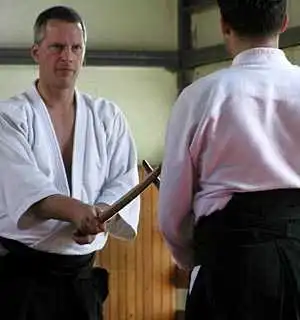 Chudan kamae.
You can try the same with shihonage, since this technique is very near to a sword cut. Of course, you can also try it with any other aikido technique, but few are as clear in this as shihonage and the sword cut. More about sword training here: Aikibatto
When you do tsuki, the straight punch, you can actually start with the fist in front of your center, and draw it back to that position after the strike. Even if you hold your hand higher before the punch, hitting should feel like extending from your center. If you lose the connection to your center when you do a technique, it becomes weak and insecure, often failing completely. In this way, tanden is a continuous guiding principle for the aikido techniques.
Center BreathingTo use one's center properly, it should also be the center of one's breathing. Of course, breathing is done by the lungs, but there are different techniques of inhaling and exhaling. The one used in aikido and all budo is what by western terminology goes as diaphragm breathing, often called belly breathing. It feels like you are breathing with your belly. What way the air actually goes is another matter.Belly breathing is a good start, but it should at length be done as if the center is at the core of it, a breathing into and out of the center. A focused belly breathing is easy enough to see — the belly is moving, but the chest not at all. Most people find it much more difficult to do than to observe, though. One has to have a good posture in order to learn a deep belly breathing. That's why it is difficult to do in a chair, where the posture tends to be bent. Sitting in seiza, the Japanese style of sitting on the floor, works better. In this position the back is more straight. The same is true for standing up or lying down on one's back.
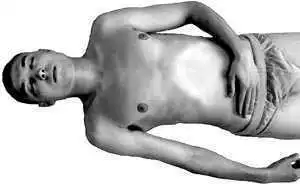 Belly breathing, lying down. When in a good posture, you can exercise belly breathing by putting your hand on the belly and making your breathing push at the hand. When you inhale, this is easy enough, but you should try also to push at your hand when exhaling. You can put your other hand on your chest, to check that it doesn't move much.
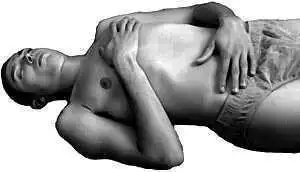 Belly breathing, checking with two hands.
Do not make the mistake of breathing in to your center by pushing air from the chest downwards. A hand on your chest would reveal that. It should feel like you actually breathe with your belly, like that is where the lungs are. You should practice belly breathing daily, in order to make it a habit. It may take a year or so, before it becomes automatic. The more you get comfortable with belly breathing, the more you should try to focus it to a center breathing. Try to make the breathing feel like you suck air all the way into your center when breathing in, and out from your center when breathing out. The whole belly keeps on moving, of course, but the center should be at the core of your breathing, as if it is the actual organ of breath. Breath is a physical sibling of ki. They behave similarly. Therefore, focusing on breathing increases the ki flow. What you actually inhale and exhale with your center is ki. Because it is ki, and not air, you can "inhale" it and "exhale" it through any part of your body. For example, when you do tsuki, you "exhale" ki from your center through your fist — specifically through the base knuckles of the index and middle finger. When you pull someone or something to you, it helps if you "inhale" ki through your grip. Normally, but not always, a movement away from you is done best with exhalation, and a movement towards you with inhalation. It is important that you exercise the feeling of breathing all the way to and all the way from inside your center.
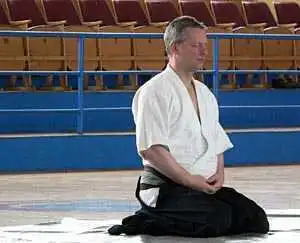 Zazen, sitting meditation.
MeditationTanden is also a center of meditation. This you can see clearly by the posture used when meditating, whether it is seiza or with crossed legs. The back is straight, the belly is accentuated, and the hands form a figure right in front of the center.When you meditate, it helps a lot if you focus on your center and try to remain in it. When this is automatic, you don't need to focus on it anymore, but just let you mind go blank — not an easy thing, either...
Self-realizationI have heard that in psychiatry they talk about centering oneself, about regaining one's center. This concerns the sense of being lost, which can befall us, since existence certainly is a bigger and more complicated thing than we always manage to deal with.People in mental confusion lose the sense of rooting, of stability, which would give them a chance to recover after emotional storms. They must learn to get deep down within themselves, peel off all mental pollution and confusion until they reach a pure and steady sensation of who they fundamentally are. We need to get rid of all distractions to find and remain ourselves, through the turmoil of living. Man's center in Eastern thinking is a similar thing. In the core of my being, there is no doubt — I am and I remain, through all the dramatic events in life. Contrary to psychiatry, though, this center is not just a mental therapy gadget or an object for concentration exercises. Tanden is something quite concrete — a nucleus in the bottom om the stomach, as palpable as the heart's beating in the chest. The center is as real as anything else in the physical world, and therefore accessible through physical means — such as deep breathing and aikido exercises.
If you exercise sensing your center in the bottom of the stomach, and use it for support whatever you do, then your certainty about your own being will grow. You regain contact with yourself, the security in both knowing that you exist and learning more and more who you are. The way to self-realization goes through tanden. In aikido training you should always focus on your center. This physical exercise of your tanden gets a mental counterpart. The more you familiarize yourself with your center in training, the more you get in touch with a center of your mind. You get rooted in life, and run less of a risk of losing your physical or your mental balance. It is through one's center that one grows whole and becomes self-assured, independent of success and victories — therefore unharmed by failure and defeat. This self-assured state of mind is simply: I am who I am.
Stefan Stenudd
Ki, life energy
My Qi Book:
QiIncrease your life energy. The life energy qi (ki) explained, with exercises on how to awaken and use it. Click the image to see the book at Amazon (paid link).More about the book here.
AIKIDO PRACTICEIntroductionAikido Techniques — all the basic movesAttacks in Aikido
Tantodori — knife defenseAikiken — aikido sword techniquesJo 31 Kata in four directionsAikibatto sword and staff exercisesAiki — joining energiesKi exercisesAikido Video ClipsAikido PhotosMy aikido dojo in Malmö, SwedenMy aikido seminarsAIKIDO THEORYMy Aikido BioAikido GlossaryTanden, the CenterAikido InksAikido as Self-DefenseRunning a DojoAikido is TrueOsensei and EinsteinAikiWeb ColumnsAikido Books ReviewedDie deutsche Version meines Aikido-Buches onlineAikido på svenskaAbout CookiesMy Other WebsitesCREATION MYTHSMyths in general and myths of creation in particular.
TAOISMThe wisdom of Taoism and the Tao Te Ching, its ancient source.
LIFE ENERGYAn encyclopedia of life energy concepts around the world.
QI ENERGY EXERCISESQi (also spelled chi or ki) explained, with exercises to increase it.
I CHINGThe ancient Chinese system of divination and free online reading.
TAROTTarot card meanings in divination and a free online spread.
ASTROLOGYThe complete horoscope chart and how to read it.
MY AMAZON PAGE
MY YOUTUBE AIKIDO
MY YOUTUBE ART
MY FACEBOOK
MY INSTAGRAM
MY TWITTER
STENUDD PÅ SVENSKA
|
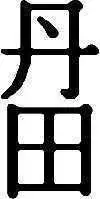
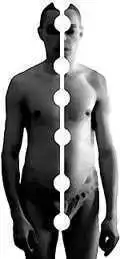
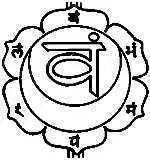
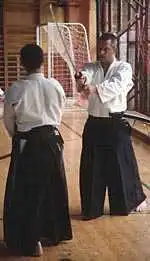
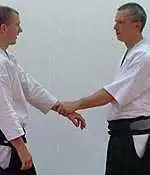
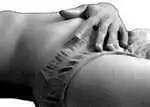
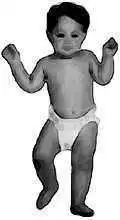
 Aikido Principles
Aikido Principles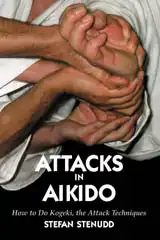 Attacks in Aikido
Attacks in Aikido Aikibatto
Aikibatto
